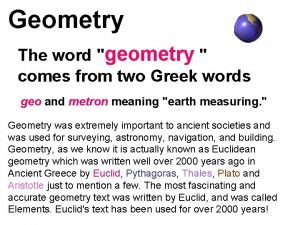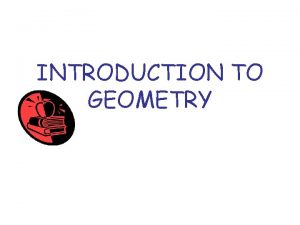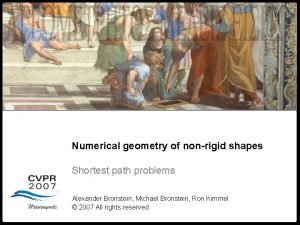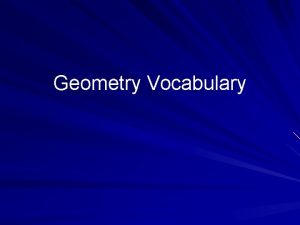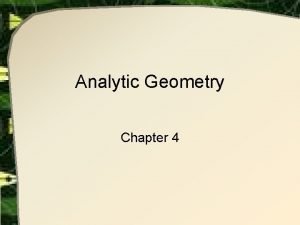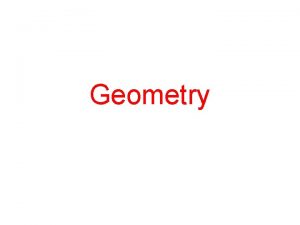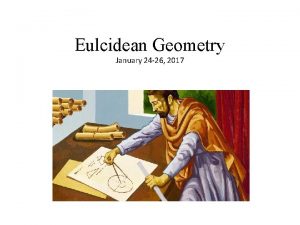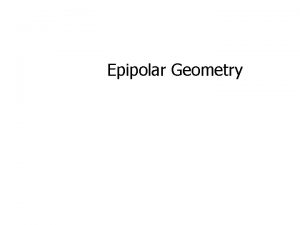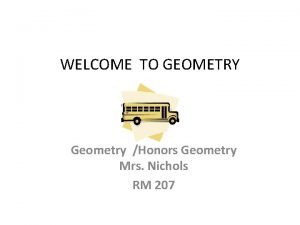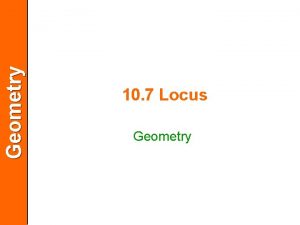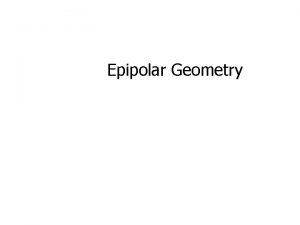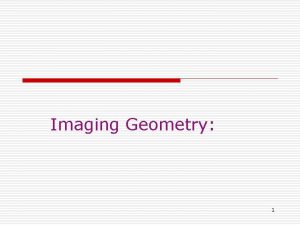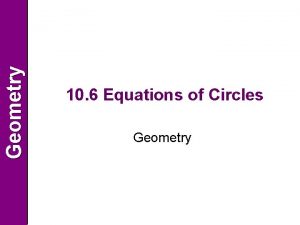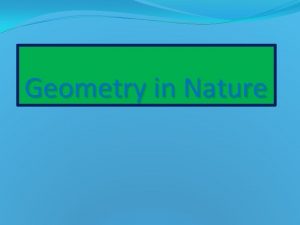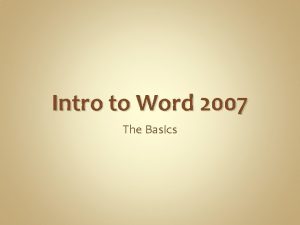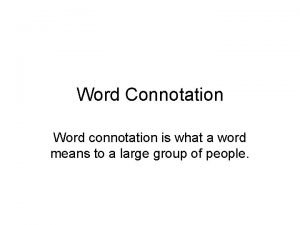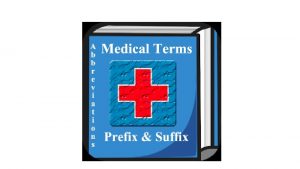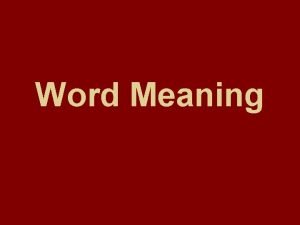1 1 Intro to Geometry Geometry The word








































- Slides: 40

1. 1 Intro to Geometry

Geometry The word "geometry " comes from two Greek words geo and metron meaning "earth measuring. " Geometry was extremely important to ancient societies and was used for surveying, astronomy, navigation, and building. Geometry, as we know it is actually known as Euclidean geometry which was written well over 2000 years ago in Ancient Greece by Euclid, Pythagoras, Thales, Plato and Aristotle just to mention a few. The most fascinating and accurate geometry text was written by Euclid, and was called Elements. Euclid's text has been used for over 2000 years!

Millenium Park Frank Lloyd Wright Millau Bridge Sir Norman Foster Fallingwaters Frank Lloyd Wright Point, Lines, Planes, Angles Components of Geometry Part 1

GEOMETRY’S UNDEFINED TERMS POINT LINE PLANE

POINT A point is a_______, or a_____.

POINT A point is not a physical object – you can not touch it, feel it, or even see it.

POINT n. A point has no size.

POINT A point can be represented by a dot. The size that you make the dot is not important because a point has no size. Make it just large enough to see.

POINT n. A point is named by using an “upper-case” “block” letter. EXAMPLE: This figure P would be called “point P”.

POINT EXAMPLE 2: X This figure would be called “point X”.

LINE n A line is a set of points that extends infinitely in 2 opposite directions. What does “infinitely” mean ? NEVER-ENDING (Goes on forever. )

LINE Why does it have EXAMPLE: arrows on both ends ? TO SHOW THAT IT EXTENDS INFINITELY IN BOTH (OPPOSITE) DIRECTIONS

NAMING A LINE There are 2 ways: Use the names of (any) two points on the line. 1. Example: X P What name(s) can we give to this line? Line ___or line____

NAMING A LINE There are 2 ways: Use a “lower-case” “cursive” letter (located near one of the arrows). 2. Example: What name can we give to this line?

NAMING A LINE There are 2 ways: 1. Use the names of (any) two points on the line. PX EXAMPLE: line PX (OR USE A “SYMBOL” FOR LINE AND WRITE IT ABOVE THE LETTERS. ) 2. Use a “lower-case” “cursive” letter (located near one of the arrows). EXAMPLE: line ____

How many names does this line have? R G K There are 7 different names that you could use to name this line. They are:

Let’s try again. How many names does this line have? F N X t There are 7 different names that you could use to name this line. They are:

ONE MORE TIME. How many names does this line have? T C Y N There are 12 different names that you could use to name this line. They are:

PLANE n A plane is a “flat surface” – a set of points that extends infinitely in 2 dimensions. What does “dimension” mean ? ____, __________. A plane is infinitely long and infinitely wide, but it has no height (or depth).

PLANE A plane can be drawn (represented) by a four sided figure known as a parallelogram.

PLANE A plane can be named by a single “upper-case” “block” letter (written near a corner of the plane). Q What is the name of this plane? Plane Q or □Q

What is the name of this plane? R F N T ANSWER: _______ • http: //search. mywebsearch. com/mywebse WHY CAN’T IT BE CALLED PLANE R or T or N ? arch/video. jhtml? searchfor=lines+planes+ point+geometry&n=77 fce 313&ss=sub&st= kwd&ptb=E 3835453 -B 3 EB-46 F 1 -B 69 F 564 B 8 FD 71 B 8 B&tpr=sbt

q. Descriptions of Defined Terms Ø Space Ø General Terms §Congruent §Similar §Equal §Union §Intersection

Ø Space Refers to the set of all points. Space goes on forever in every direction, and therefore has length, width, and depth. Space has no special notations. It is simply referred to as space. Space contains at least 4 points that are not all on the same plane.

Ø General Terms §Congruent §Similar §Equal §Union §Intersection

§Congruent @ or congruent shapes are the same shape and size; therefore, after some movement of the shapes they can be made to fit exactly on top of one another.

§Congruent @ or congruent shapes are the same shape and size; therefore, after some movement of the shapes they can be made to fit exactly on top of one another.

§Similar ~ or similar shapes are the same shape, but can be different sizes; thus congruent shapes are also similar shapes, but similar shapes are not necessarily congruent shapes.

§Equal = or equal can apply to sets of points being exactly the same set or to numerical measurements being exactly the same number values.

§Union È or union refers to putting all of the points together and describing the result.

§Intersection Ç or intersection refers to describing only those points that are common to all sets involved in the intersection or to describing the points where indicated shapes touch.

Ray n Symbolized by Let’s look at a ray: A is called the initial point A B Ray AB extends in one direction without end. The initial point is always the first letter in naming a ray. Notice the difference in symbols from both a line and segment.

Symbol alert! n. Not all symbols are created equal! is the same as A B BUT…

Symbol alert!! The ray is different! Initial point 1 st is not the same as A B Notice that the initial point is listed first in the symbol. Also note that the symbolic ray always has the arrowhead on the right regardless of the direction of the ray.

Opposite Rays n. If B, C is between A and then A C and B are opposite rays. C is the common initial point for the rays!

Angles n. Rays are important because they help us define something very important in geometry…Angles! n. An angle consists of two different rays that have the same initial point. The rays are sides of the angles. The initial point is called the vertex. Notation: We denote an angle with vertex B sides A C three points and symbol. The middle point is always the vertex. We can also name the angle with just the vertex point. This angle can be denoted as:

Classifying Angles n. Angles are classified as acute, right, obtuse, and straight, according to their measures. Angles have measures greater than 0° and less or equal to 180°. A Acute angle 0°< m 90° A< A A Right angle Obtuse angle m A= 90°< m 180° A A< Straight angle m A = 180°


Intersections of lines and planes • • Two or more geometric figures intersect if they have one or more points in common. The intersection of the figures is the set of points the figure has in common How do 2 line intersect? How do 2 planes intersect? What about a line and a plane?

Modeling Intersections n To think about the questions on the last slide lets look at the following… Point E is the E Two lines intersect at a point, like here at point A. A B F D H C G Line BF is the intersection of the planes G and H. intersection of plane H and line EC
 The greek word “geo” in geometry means ____.
The greek word “geo” in geometry means ____. Molecular geometry of pf3
Molecular geometry of pf3 Electron domain geometry vs molecular geometry
Electron domain geometry vs molecular geometry The basis of the vsepr model of molecular bonding is
The basis of the vsepr model of molecular bonding is Hát kết hợp bộ gõ cơ thể
Hát kết hợp bộ gõ cơ thể Bổ thể
Bổ thể Tỉ lệ cơ thể trẻ em
Tỉ lệ cơ thể trẻ em Chó sói
Chó sói Thang điểm glasgow
Thang điểm glasgow Chúa yêu trần thế alleluia
Chúa yêu trần thế alleluia Các môn thể thao bắt đầu bằng tiếng chạy
Các môn thể thao bắt đầu bằng tiếng chạy Thế nào là hệ số cao nhất
Thế nào là hệ số cao nhất Các châu lục và đại dương trên thế giới
Các châu lục và đại dương trên thế giới Cong thức tính động năng
Cong thức tính động năng Trời xanh đây là của chúng ta thể thơ
Trời xanh đây là của chúng ta thể thơ Cách giải mật thư tọa độ
Cách giải mật thư tọa độ 101012 bằng
101012 bằng độ dài liên kết
độ dài liên kết Các châu lục và đại dương trên thế giới
Các châu lục và đại dương trên thế giới Thể thơ truyền thống
Thể thơ truyền thống Quá trình desamine hóa có thể tạo ra
Quá trình desamine hóa có thể tạo ra Một số thể thơ truyền thống
Một số thể thơ truyền thống Cái miệng xinh xinh thế chỉ nói điều hay thôi
Cái miệng xinh xinh thế chỉ nói điều hay thôi Vẽ hình chiếu vuông góc của vật thể sau
Vẽ hình chiếu vuông góc của vật thể sau Thế nào là sự mỏi cơ
Thế nào là sự mỏi cơ đặc điểm cơ thể của người tối cổ
đặc điểm cơ thể của người tối cổ Ví dụ về giọng cùng tên
Ví dụ về giọng cùng tên Vẽ hình chiếu đứng bằng cạnh của vật thể
Vẽ hình chiếu đứng bằng cạnh của vật thể Fecboak
Fecboak Thẻ vin
Thẻ vin đại từ thay thế
đại từ thay thế điện thế nghỉ
điện thế nghỉ Tư thế ngồi viết
Tư thế ngồi viết Diễn thế sinh thái là
Diễn thế sinh thái là Các loại đột biến cấu trúc nhiễm sắc thể
Các loại đột biến cấu trúc nhiễm sắc thể Các số nguyên tố
Các số nguyên tố Tư thế ngồi viết
Tư thế ngồi viết Lời thề hippocrates
Lời thề hippocrates Thiếu nhi thế giới liên hoan
Thiếu nhi thế giới liên hoan ưu thế lai là gì
ưu thế lai là gì
